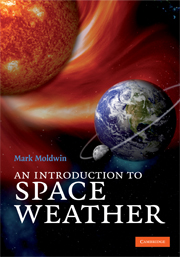Book contents
- Frontmatter
- Contents
- Preface
- Acknowledgments
- 1 What is space weather?
- 2 The variable Sun
- 3 The heliosphere
- 4 Earth's space environment
- 5 Earth's upper atmosphere
- 6 The technological impacts of space storms
- 7 The perils of living in space
- 8 Other space weather phenomena
- Appendix A Web resources
- Appendix B SI units
- Appendix C SI prefixes
- References
- Historical bibliography
- Index
- Plate section
6 - The technological impacts of space storms
- Frontmatter
- Contents
- Preface
- Acknowledgments
- 1 What is space weather?
- 2 The variable Sun
- 3 The heliosphere
- 4 Earth's space environment
- 5 Earth's upper atmosphere
- 6 The technological impacts of space storms
- 7 The perils of living in space
- 8 Other space weather phenomena
- Appendix A Web resources
- Appendix B SI units
- Appendix C SI prefixes
- References
- Historical bibliography
- Index
- Plate section
Summary
However, I would like to close by mentioning a possibility of the more remote future – perhaps half a century ahead.
An “artificial satellite” at the correct distance from the earth would make one revolution every 24 hours; i.e., it would remain stationary above the same spot and would be within optical range of nearly half the earth's surface. Three repeater stations, 120 degrees apart in the correct orbit, could give television and microwave coverage to the entire planet. I'm afraid this isn't going to be of the slightest use to our post-war planners, but I think it is the ultimate solution to the problem.
Arthur C. Clarke Letter to the Editor, Wireless World, 58, February 1945. (The first suggestion of global communication using geosynchronous orbit satellites. The prediction came true in 20 years with the launch of the first geosynchronous satellite in 1965.)Key concepts
atmospheric drag
radiation effect on satellites
radio wave propagation
Faraday's law of induction
Introduction
Space weather has broad, everyday impacts on humans and technology. Spacecraft and astronauts are directly exposed to intense radiation that can damage or disable systems and sicken or kill astronauts. Radio signals from satellites to ground communication and navigation systems, such as the Global Positioning System (GPS), are directly affected by changing space environment conditions.
Information
- Type
- Chapter
- Information
- An Introduction to Space Weather , pp. 79 - 94Publisher: Cambridge University PressPrint publication year: 2008
Accessibility standard: Unknown
Why this information is here
This section outlines the accessibility features of this content - including support for screen readers, full keyboard navigation and high-contrast display options. This may not be relevant for you.Accessibility Information
- 1
- Cited by
